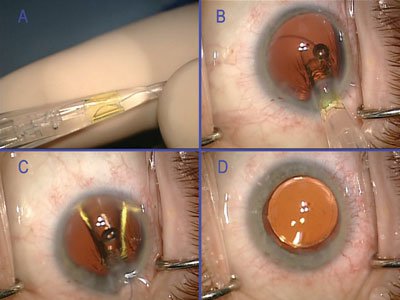Warming viscoelastics, lens implants can be beneficial
The practice of cooling these materials to subphysiologic temperatures hampers their functional characteristics.
 Uday Devgan |
We have learned that the ultrasonic vibrations used in phacoemulsification can generate heat substantial enough to cause a wound burn. This risk has been greatly reduced using the concepts of phaco power modulation, protection with a silicone sleeve and fluidic cooling of the phaco needle using irrigating solutions. It is clear that we want to avoid excessive heat during all steps of cataract surgery, but is cooling of the eye, lens and viscoelastic to subphysiologic temperatures ideal?
There are three main temperatures during cataract surgery: the refrigerator where ophthalmic viscosurgical devices (OVDs) are often stored (38° F, 3° C), the operating room ambient temperature where lens implants and irrigating solutions are kept (68° F, 20° C) and the physiologic body temperature (98° F, 37° C). Although it is important to store viscoelastics, lens implants and irrigating solutions at their suggested temperatures, there may be a beneficial effect to warming them to physiologic body temperature.
Ophthalmic viscosurgical devices
The rheological properties of viscoelastics vary with temperature: colder temperatures cause OVDs to become more viscous, less elastic and more resistant to flow. When filling an eye with a dispersive viscoelastic that is at refrigerator temperature (38° F, 3° C), it is noted to be more solid, with the OVD filling the anterior chamber in a string-like manner. With warming to room temperature, the same dispersive OVD now fills the anterior chamber like a wave, allowing a better exchange with the aqueous.
If the OVD is warmed to near the physiologic body temperature, the viscosity is lower still, with a more fluid application into the eye. With a more solid, wavelike application of OVD to the anterior chamber, there is a better barrier effect to protect the corneal endothelium from the ultrasonic energy and irrigating fluids of phacoemulsification.
IOL implants
With rigid, non-foldable lens implants, temperature did not seem to make much difference. But with the advent of foldable and injectable lenses, particularly those made of acrylic, temperature becomes important. The earlier-generation foldable acrylic IOLs were often warmed by surgeons, using radiated heat from machinery in the operating room, to facilitate lens folding with forceps. This became less common with the use of IOL injectors, but revisiting this idea may be worthwhile.
 The Hoya iSert preloaded IOL (A) has been warmed to physiologic body temperature (98° F, 37° C) and the injector has been filled with warmed viscoelastic. This allows the IOL to fold into its compressed form easily and symmetrically in preparation for insertion. (B) The IOL is inserted using the lens injector. The warmed IOL allows for controlled, smooth delivery. (C) With the physiologic body temperature of the IOL, unfolding is immediate and complete within seconds. (D) The IOL achieves its final configuration and position quickly, resulting in excellent centration behind the capsulorrhexis. Image: Devgan U |
The properties of acrylic IOLs change dramatically with temperature: a physiologic temperature results in a soft, flexible lens that folds and unfolds easily, whereas the cooler operating room temperature causes the lens to be stiffer and more resistant to folding and unfolding.
I recently examined this idea with the iSert IOL (Hoya Surgical Optics). This is a hydrophobic acrylic IOL that is preloaded into an injector; advancing the plunger automatically folds the IOL and delivers it through an incision size of 2.4 mm. With the IOL and OVD stored at the typical operating room temperature (68° F, 20° C), the iSert lens advances down the injector and folds in a slow and controlled manner and is then delivered into the eye, where it takes approximately 10 to 12 seconds to completely unfold. When the IOL and OVD were warmed to a physiologic body temperature first (98° F, 37° C), the lens folded more easily and with equal control as it was advanced down the injector barrel. Upon insertion into the eye, the lens unfolded immediately and completely within just 4 to 6 seconds. Conversely, storing the lens and OVD at refrigerator temperatures hampered the process of folding and injecting and required 30 seconds for complete unfolding upon insertion. I have repeated this test with hydrophobic acrylic IOLs from other manufacturers with similar results.
Effect of temperature on inflammation
Since temperature (calor) is one of the cardinal signs of inflammation (rubor, calor, tumor, dolor), cooling the irrigating solutions may have a beneficial effect during cataract surgery. In addition, the heat created from the ultrasonic motion of the phaco needle can be offset by the cooled infusion fluid. Cold balanced salt solution has been used in other types of ocular surgery as well, in mitigating pain and haze formation after excimer laser PRK.
Since OVDs and acrylic IOLs improve their functional characteristics when used at a physiologic body temperature, it makes sense to warm them prior to use. Because irrigating solutions may confer more protection when used at colder temperatures, storing them at refrigerator temperatures may amplify that benefit.
I would like to thank Kevin L. Waltz, OD, MD, for his insight into the effect of temperature on OVDs and IOLs.

- Uday Devgan, MD, FACS, FRCS (Glasg), is in private practice at Devgan Eye Surgery in Los Angeles, Beverly Hills and Newport Beach, Calif. He is also chief of ophthalmology at Olive View UCLA Medical Center and associate clinical professor at the UCLA School of Medicine. Dr. Devgan can be reached at 11600 Wilshire Blvd., Suite 200, Los Angeles, CA 90025; 800-337-1969; fax: 310-388-3028; e-mail: devgan@gmail.com; website: www.DevganEye.com. Dr. Devgan is a consultant to Hoya Surgical Optics.
